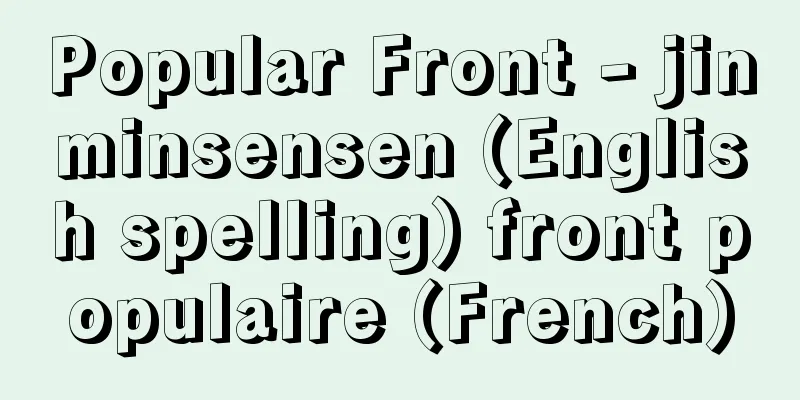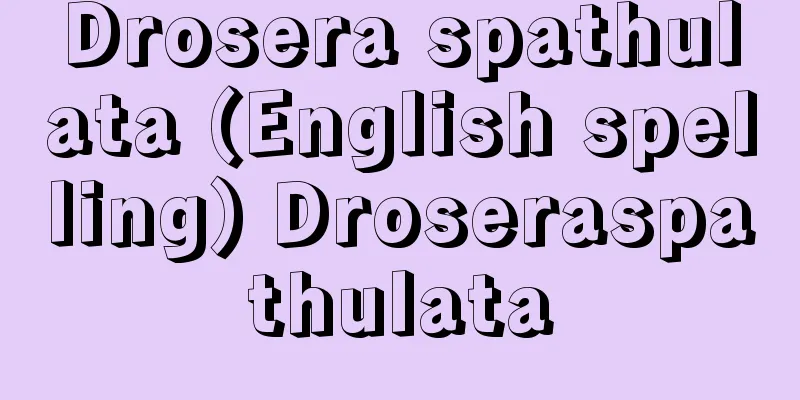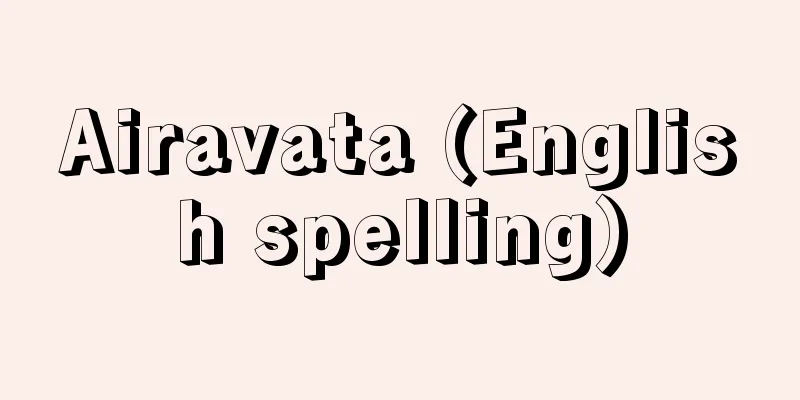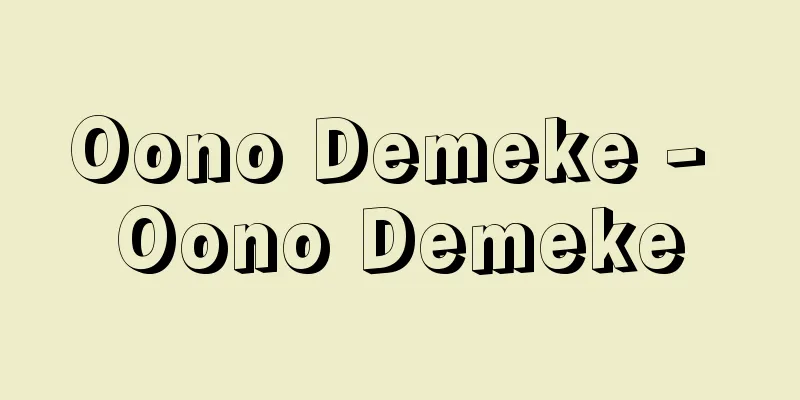Popular Front - jinminsensen (English spelling) front populaire (French)

|
The United Front Movement was organized in the 1930s to oppose the rise of Fascism. Popular Front governments were established in France and Spain. However, this movement was closely linked to the change in direction of the international communist movement since the Russian Revolution, and had a major impact on other countries. It attracted attention not only in political terms, but also in ideological and cultural terms as an attempt to open up new possibilities in an era shaken by the threat of fascism, and marked a period on the eve of World War II. [Haruyasu Kato] FranceIn 1933, Hitler came to power in Germany and the threat of fascism grew internationally. On February 6, 1934, right-wing and fascist groups attacked the government and parliament in France. At the time, the Socialist Party and the Communist Party had been in conflict since their split in 1920, and the labor movement was also divided. Moreover, the fact that Comintern had targeted social democracy as its first attack target, as it saw it as opening the way to fascism, significantly weakened the resistance of the labor movement and other groups against fascism. However, efforts to overcome this divided situation had appeared at lower levels, such as the Seine departmental branch of the Socialist Party. There was also an attempt in 1933 to form a "united front" led by former Radical Socialist Gaston Bergery. Meanwhile, in August 1932, an international anti-war conference was held in Amsterdam at the suggestion of writers Henri Barbusse and Romain Rolland, and the name of the venue for the second conference, held in Paris the following year, gave birth to a movement centered around intellectuals known as the Amsterdam Pleyel Movement. In this context, the February 6th incident shocked people, and the momentum for anti-fascist forces to unite and take mass action rapidly expanded. On February 12th, the Communist-affiliated General Confederation of United Labor (CGTU) joined a general strike proposed by the General Confederation of Labor (CGT), and the Socialist and Communist parties each organized demonstrations, marking the first step toward joint action. The process leading to the formation of the Popular Front involved a movement to unify the front with an agreement on action at the party level, which included the Socialist Party, the Communist Party, and the Radical Socialist Party; an attempt at a movement that transcended party lines and included cultural exploration centered on intellectuals; and people's movements from below, including hopes for a new direction that would transcend reality in the face of growing crises. After February, the first conscious move toward a unified movement to appear on the surface was the establishment of the Anti-Fascist Intellectuals Monitoring Committee on March 5. In this atmosphere, the Socialist Party and the Communist Party signed a unified action agreement on July 27 of the same year. In the following year, 1935, at the suggestion of the Amsterdam Pleyel Movement, a unified demonstration was planned for July 14, and a committee for this purpose was organized in June by the Socialist and Communist Parties, the Radical Socialist Party, the CGT, the CGTU, the Intellectuals Monitoring Committee, as well as representatives of the Human Rights League and the Youth and Women's Movement. July 14 became the day of large-scale demonstrations in Paris and other places, and the Popular Front was thus established. Behind the Communist Party's approach to the Radical Socialist Party and its advocacy for the defense of the republic lay a change in the foreign policy of the Soviet Union, which had sought to break out of international isolation by concluding the Franco-Soviet Mutual Assistance Agreement in May of that year, and a shift in Comintern policy. The 7th Congress of Comintern, held at the end of July, highly praised the formation of the French Popular Front and set the task of the international communist movement as the formation of a united anti-fascist front. In the parliamentary elections held in April and May 1936, the Popular Front won a landslide victory, and the Socialist Party became the largest party. As a result, the Popular Front government was formed on June 4th, with Socialist Léon Blum as Prime Minister. During this time, a wave of strikes broke out, with workers occupying factories around the time of the elections, and in June it expanded to an unprecedented scale. This was an eruption of people's desire to express their will directly and their hopes for new possibilities, which also took on the appearance of a celebration of the victory of the Popular Front. The new government had the representatives of the General Confederation of Labor (the CGT and CGTU had merged in March 1936) and the representatives of management sign an agreement on June 8th (the Matignon Agreement) that allowed for wage increases and freedom of union activity, while also passing a series of labor and social legislation, such as paid holidays, collective agreements, and a 40-hour work week. A new Agency for Leisure and Sports was also established within the government, and it aimed to organize and popularize vacation travel and sports. However, the Popular Front government was short-lived. In the Spanish Civil War that had just begun, the Leon Blum government adopted a policy of non-intervention, proving its powerlessness in the face of the offensive of international fascism, relying instead on the old international order. Furthermore, the government was unable to effectively deal with the financial and economic difficulties brought about by capital flight and other factors, except by devaluing the exchange rate. Furthermore, in response to resistance from the capitalists and new right-wing activities, the government feared an outpouring of popular energy, as manifested by factory occupations, and so on, which instead led to the loss of the bottom-up vitality that had supported the formation of the Popular Front. On February 13, 1937, Leon Blum announced a "temporary suspension" of the Popular Front policy, and on June 22, following the rejection of a bill calling for full financial authority, he was forced to resign en masse. A series of short-lived Popular Front cabinets followed, including the second Blum cabinet formed in March-April 1938, but the split between the Radical Socialist Party and the Communist Party in November of the same year brought an end to the Popular Front. [Haruyasu Kato] SpainOn January 15, 1936, an agreement was concluded in Spain under the name of the Popular Front between the Republican Left, the Socialist Party, the Communist Party, the Workers' Party of Marxist Unity (POUM), the General Confederation of Labor, and other parties. This was primarily a tactical agreement for the elections scheduled for February, but the Popular Front won the elections by gaining a majority, and on February 19, a Popular Front cabinet was formed with Manuel Azaña, the central figure of the Republican Left, as prime minister (Azaña became president on May 10). The election victory was greeted by an intense upsurge in mass actions that had been oppressed since 1933 under the growing reactionary trend known as the "two dark years." Workers' strikes, attacks on churches, which were also symbols of reaction, the release of political prisoners, and the occupation of land by tenant farmers in rural areas spread throughout the country, while terrorist attacks by right-wing and fascist groups in opposition to the Popular Front occurred frequently. The Popular Front went beyond the electoral agreement, and the government, although shaken, set out certain reform directions, including land reform, and Spain gradually became a battleground for direct confrontation between the Popular Front and fascism and right-wing conservative forces. The situation was solidified by the revolt started by the military in Spanish Morocco on July 17. Spain then entered into a civil war that lasted for nearly three years, and became an international focal point due to the intervention of Germany and Italy, which supported the rebels. [Haruyasu Kato] "Documents of Modern History 6: The Popular Front" edited by Takeuchi Yoshitomo (1973, Heibonsha)" ▽ "The French Popular Front, by Danos and Gibran, translated by Yoshida Yaeko (1972, Tsuge Shobo)" ▽ "The French Popular Front, by Hirase Tetsuya (1974, Kondo Publishing)" ▽ "The French Popular Front, by Lefranc, translated by Takahashi Haruo (Hakusuisha, Que sais-je paperback)" ▽ "The Spanish Civil War I and II, by Hugh Thomas, translated by Tsuzuki Chuichi (1962, 1963, Misuzu Shobo)" ▽ "The Spanish Labyrinth, by Brennan, translated by Suzuki Takashi (1967, Godo Shuppan)" ▽ "Documents of Modern History 7: The Spanish Revolution" edited by Yamauchi Akira (1973, Heibonsha) [References] |Source: Shogakukan Encyclopedia Nipponica About Encyclopedia Nipponica Information | Legend |
|
1930年代、ファシズムの台頭に抗して組織された統一戦線運動。フランスとスペインでは人民戦線政府が成立した。しかし、この運動はロシア革命以来の国際共産主義運動の方向転換と密接に関連していて、他の諸国にも大きな影響を与えた。また、政治面だけではなく、ファシズムの危機に揺らぐ時代状況のなかで新たな可能性を開く試みとして思想・文化の面でも注目を集め、第二次世界大戦前夜の一時期を画した。 [加藤晴康] フランス1933年ドイツでヒトラーが政権を握り国際的にファシズムの脅威が増大するなかで、フランスでは34年2月6日、右翼・ファッショ的諸団体が政府、議会を攻撃する騒乱事件が起こった。当時、社会党と共産党は1920年に分裂して以来対立状態にあり、労働運動も分裂していた。しかも国際的にコミンテルンが社会民主主義をファシズムに道を開くものとして第一の攻撃目標としていたことは、ファシズムに対する労働運動などの抵抗力を著しく弱くしていた。しかし、その分裂状況を超えようとする動きは、社会党のセーヌ県連など下部において現れていた。また、1933年元急進社会党のガストン・ベルジュリを中心にする「共同戦線」の名をとった試みもあった。他方、1932年8月、作家のアンリ・バルビュスやロマン・ロランらの提唱によりアムステルダムで国際反戦大会が開かれ、翌年パリで行われた2回目の大会の会場の名とあわせて、アムステルダム・プレイエル運動とよばれる知識人を中心にする運動が生み出されていた。こうした状況のなかで二月六日事件は人々に衝撃を与え、反ファッショ勢力結集と大衆的な行動の機運は急速に拡大することとなった。2月12日、労働総同盟(CGT)の提唱したゼネストに共産党系の統一労働総同盟(CGTU)も参加、また社共両党がそれぞれデモを組織し、共同行動への最初の一歩となった。 人民戦線形成に至る過程には、社会党、共産党、それに急進社会党を加える政党レベルでの行動協定を伴う戦線統一の動きと、知識人を中心として文化的模索をはらんだ党派を超える運動の試み、それに、増大する危機に直面しつつ、現実を超える新たな方向への期待を含めた下からの人々の動きが絡み合っている。2月以後、統一した運動への意識的な動きとしてまず表面に現れたのは、3月5日に発足した反ファシスト知識人監視委員会であった。社会党と共産党はこうした機運のなかで同年の7月27日、統一行動協定に調印した。翌35年、アムステルダム・プレイエル運動の提唱で7月14日を期して統一示威運動を行うことが計画され、6月そのための委員会が社共両党に急進社会党も加わり、またCGT、CGTU、さらに知識人監視委員会のほか、人権連盟や青年婦人運動などの代表も参加して組織された。7月14日はパリをはじめ各地での大規模な示威行動の日となり、人民戦線はここに成立した。共産党が急進社会党と接近し共和政擁護を掲げた背後には、同年5月仏ソ相互援助協定を結んで、国際的に孤立から脱却しようとしていた当時のソ連の外交政策の変化と、コミンテルンの政策転換の動きがあった。7月末より開かれたコミンテルン第7回大会は、フランス人民戦線の結成を高く評価し、国際共産主義運動の課題を反ファシズム統一戦線の形成に置いた。 1936年4~5月に行われた議会選挙で人民戦線派が圧勝し、社会党が第一党となった。この結果、6月4日に社会党のレオン・ブルムを首相とする人民戦線内閣が生まれた。この間、選挙の時期より労働者による工場占拠を伴ったストライキの波が起こり、6月には未曽有(みぞう)の規模で拡大した。これは人々による直接的な意志表示の欲求と新たな可能性への期待が、人民戦線の勝利の祝祭という様相をも呈しながら噴出したものであった。新政府は労働総同盟代表(CGTとCGTUは1936年3月合同を実現していた)と経営者側代表との間に、賃上げや組合運動の自由を認める協定を6月8日に締結(マチニヨン協定)させる一方、有給休暇、団体協約、週40時間労働などの労働・社会立法を相次いで成立させた。また政府内に新たに余暇・スポーツ庁が設けられ、休暇旅行やスポーツの組織化と大衆的普及が計られた。しかし人民戦線政府は短命に終わった。おりから始まったスペイン内戦にレオン・ブルム政府は不干渉政策をとり、国際的なファシズムの攻勢に対して、この政府が旧来の国際秩序に寄りかかった無力なものであることを示した。また資本の国外流出をはじめとしてもたらされた財政・経済困難に対し、政府は平価切下げを行うなどのほかに有効に対処しえなかった。そして、資本家の側の抵抗や右翼の新たな活動に対し、工場占拠などで示された大衆的エネルギーの噴出を恐れた政府は、かえって、人民戦線の形成を支えた下からの活力を失わせていった。1937年2月13日レオン・ブルムは人民戦線政策の「一時停止」を表明、6月22日には財政全権を求める法案否決を機に総辞職に追い込まれた。その後も人民戦線派の短命内閣が続き、1938年3~4月には第二次ブルム内閣も組閣されたが、同年11月急進社会党と共産党が決裂することにより、人民戦線は完全に終止符を打った。 [加藤晴康] スペインスペインでは1936年1月15日、共和主義左派、社会党、共産党、マルクス主義統一労働者党(POUM)、労働総同盟などの間で人民戦線の名をとった協定が成立した。これは2月に予定されていた選挙のための戦術協定という性格が強かったが、選挙において人民戦線派が過半数を獲得する勝利を収め、2月19日共和主義左派の中心マヌエル・アサニャを首相とする人民戦線内閣が誕生した(アサニャは5月10日大統領となる)。選挙の勝利は、1933年来「暗い2年間」とよばれる反動化の進行の下で弾圧を受けてきた大衆行動の激しい高揚によって迎えられた。労働者のストライキ、反動のシンボルでもあった教会の襲撃、政治犯の釈放、農村における小作農民による土地占拠などが各地に広がり、他方で人民戦線に反発する右翼やファッショ団体のテロが頻発した。人民戦線は選挙協定の枠を越え、政府は動揺しつつも土地改革を含めて一定の改革の方向を打ち出し、スペインはしだいに人民戦線とファシズム、右翼保守勢力との直接対決の場となっていった。7月17日、スペイン領モロッコで軍部が起こした反乱は、この状況を決定づけた。以来スペインは3年近くに及ぶ内戦に入り、反乱側を援助するドイツ、イタリアの介入により、国際的な焦点となったのである。 [加藤晴康] 『竹内良知編『ドキュメント現代史6 人民戦線』(1973・平凡社)』▽『ダノス、ジブラン著、吉田八重子訳『フランス人民戦線』(1972・柘植書房)』▽『平瀬徹也著『フランス人民戦線』(1974・近藤出版社)』▽『ルフラン著、高橋治男訳『フランス人民戦線』(白水社・文庫クセジュ)』▽『ヒュー・トマス著、都築忠七訳『スペイン市民戦争Ⅰ・Ⅱ』(1962、63・みすず書房)』▽『ブレナン著、鈴木隆訳『スペインの迷路』(1967・合同出版)』▽『山内明編『ドキュメント現代史7 スペイン革命』(1973・平凡社)』 [参照項目] |出典 小学館 日本大百科全書(ニッポニカ)日本大百科全書(ニッポニカ)について 情報 | 凡例 |
<<: Popular Front Incident - People's Front Incident
Recommend
Oboi - worship
…Because he was a young emperor, four regents wer...
Ring opening
In a reaction of a cyclic compound, the ring is cl...
Peary - Robert Edwin Peary
American explorer and naval officer. Born in Cres...
External inhibition
...In contrast, in pathological or emotionally ex...
Original - Ganso
〘 noun 〙① The first in a family line. Also, the pe...
Omoriza - Omoriza
...The upper three are Yamashina-za in Yamashina,...
Citation - Suiko
In ancient times, interest-bearing loans of rice,...
Gita Govinda (English spelling)
An Indian Sanskrit lyric poem. The Japanese transl...
Conscientious objection - ryousintekiheikikyohi
Refusing to serve in the military in accordance wi...
Gagabuta - Gagabuta
A perennial aquatic plant of the Menyanthaceae fa...
Herring
...A migratory fish of the polar zone (illustrati...
Onta ware
Pottery produced in the Onta area of Hita City, ...
Kawashima [town] - Kawashima
An old town in Hashima County, located on an islan...
Township - Township
A rectangular land division system in the Midwest...
amrta (English spelling)
…Brahma (Brahma) was born from a lotus flower tha...









